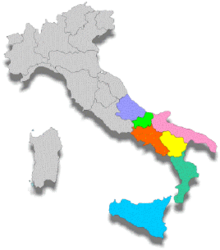Albanians in Italy
The Albanians in Italy ( Albanian Shqiptarët në Itali , Italian Albanesi in Italia ) had several phases. The Arbëresh ( long -established Albanian ethnic minority in central and southern Italy ) came to the Kingdom of Naples sporadically between the 13th and 15th centuries in several smaller and larger waves of migration . They were mercenaries who were in the service of the local feudal lords and the kings of Naples . After the death of the Albanian national hero Skanderbeg (1468) and after the conquests of Kruja (1478) and Shkodra (1479) by the Ottomans , there were several large waves of refugees up to the end of the 18th century to escape the Ottoman yoke.
Since 1991 (after the dissolution of the Socialist People's Republic of Albania and thus the communist dictatorship under the autocrat Enver Hoxha ), Italy has been more affected by poverty immigration from the Republic of Albania . Many Albanians came illegally across the Strait of Otranto to Italy in 1997 , especially during the civil war-like uprising against the Ponzi scheme . Up to 500,000 Albanians have left their country for Italy since 1991, Albanian people also immigrate to Italy from Kosovo and Macedonia / Montenegro .
immigration
According to data from the National Institute for Statistics (ISTAT) dated January 1, 2015, 498,419 Albanian citizens lived in Italy. That is 8.9% of the foreign population in Italy. Thus the number of Albanians has increased by 55% since 2005. In addition, there are 77,703 Macedonian citizens living in Italy, for whom the nationalist side assumes that 90% can be assigned to the Albanian population group . There are also around 50,000 Kosovar citizens. The naturalized Albanians are not included in the statistics.
The Arbëresh played an important role in the history of southern Italy. The Albanian army helped the then King of Naples , Ludwig II of Anjou , to bring a rebellious uprising to victory. In return, Italy granted Christian Albanians protection from the Ottomans . Many generations later, the Italians needed further military aid from the Albanians. This time the Albanians headed for Italy under Skanderbeg's leadership . Skanderbeg formed a strong alliance between the two sides and became the commander of a Neapolitan-Albanian army.
Originally, between 800,000 and 2,000,000 long-established Albanians lived in Italy (according to Albanian nationalist information), of whom between 100,000 and 260,000 speak the Arbëresh dialect. Albanian is the official language in some areas of Italy.
While the Italo-Albanian Arbëresh live in Basilicata , Calabria and Sicily , the modern Albanians immigrated mainly to the wealthy regions of northern Italy such as Lombardy , Tuscany and Emilia-Romagna .
Web links
- Albanian Calabria. In: Wdr.de. Retrieved March 3, 2017 .
- The History of Albanians in Italy. In: Initaly.com. Retrieved March 3, 2017 (English).
- Kosovari in Italia (Kosovars in Italy). In: Tuttitalia.it. Retrieved March 3, 2017 (Italian).
- Macedoni in Italia (Macedonians in Italy). In: Tuttitalia.it. Retrieved March 3, 2017 (Italian).
Individual evidence
- ↑ Cittadini non comunitari: presenza, nuovi ingressi e acquisizioni di cittadinanza , accessed on October 22, 2016
- ^ A stronger alliance was formed between the two nations and Skanderbeg became the new commander of the Neapolitan-Albanian army.
- ^ Many of these villages still exist in Southern Italy. Over 800,000 Albanians in Italy speak a language called Arbëresh, which derives from the Tosk dialect spoken in southern Albania.
- ↑ At the end of the 15th century, many Albanians left their homeland, which was then conquered by the army of the Ottoman Empire. Across the Adriatic, the Catholic Kingdom of Naples took in the refugees.

